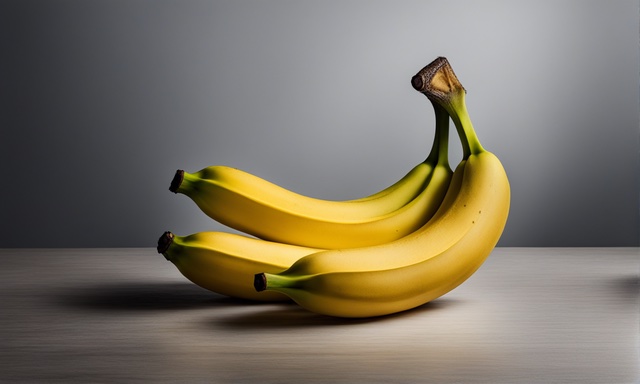Internet Asks: "Banana Color"
Bananas, a beloved fruit worldwide, are known not just for their distinct taste and nutritional benefits but also for their changing colors. From green to yellow and eventually brown, the color of a banana tells a story about its ripeness, taste, and nutritional profile. Let's delve into the vibrant world of banana color and discover what each shade signifies.
sponsored links

The Colorful Stages of Banana Ripeness
-
1. Green: The Beginning
- Stage: Unripe
- Characteristics: Firm texture, starchy flavor
- Nutritional Aspect: High in resistant starch, lower in sugars
- Use: Ideal for cooking, as seen in dishes like plantain chips or green banana curry.
-
2. Yellow with Green Tips: The Transitional Phase
- Stage: Semi-ripe
- Characteristics: Slightly softer, balanced sweetness
- Nutritional Aspect: Developing sugars, retaining some starch
- Use: Perfect for those who prefer a less sweet taste.
-
3. Bright Yellow: The Classic
- Stage: Fully ripe
- Characteristics: Soft, creamy texture with a sweet flavor
- Nutritional Aspect: Rich in sugars, easier to digest
- Use: Great for eating raw, in smoothies, or banana bread.
-
4. Yellow with Brown Spots: The Sweet Spot
- Stage: Extra ripe
- Characteristics: Very sweet, highly aromatic
- Nutritional Aspect: High in antioxidants, natural sugars fully developed
- Use: Ideal for baking, as the sweetness and texture enhance cakes and muffins.
-
5. Brown: The Overripe Stage
- Stage: Overripe
- Characteristics: Very soft, almost mushy, intense sweetness
- Nutritional Aspect: Highest level of antioxidants, some nutrient loss
- Use: Best used in recipes like banana pancakes or smoothies where texture is less critical.
Choosing the Right Banana for Your Needs
- - For Weight Management and Diabetics: Green bananas have a lower glycemic index compared to yellow or brown bananas, making them a better option for those managing blood sugar levels.
- - For Immediate Energy: Yellow bananas are an excellent choice for a quick energy boost.
- - For Baking and Desserts: Green bananas are less sweet and more starchy, making them great for cooking, like in the Caribbean dish "green banana porridge." Yellow bananas are perfect for eating raw, while brown bananas are ideal for baking due to their softness and natural sweetness.
sponsored links
The Science Behind the Color Change
- - Natural Ripening Agent: Bananas release ethylene gas, which accelerates ripening. This is why placing a banana next to other fruits can ripen them faster.
- - Enzymatic Breakdown: As bananas ripen, enzymes convert starch into glucose, fructose, and sucrose, altering the taste and color.
Interesting Facts About Banana Colors
- - Climate Impact: Temperature and humidity can affect the rate of color change in bananas.
- - Storage Tips: Bananas ripen slower in cooler temperatures. If you wish to slow down the ripening process, keep them in the fridge. The skin will darken, but the fruit inside remains unaffected.
Conclusion
The color of a banana is not just a marker of its ripening stage but also an indicator of its texture, taste, and nutritional content. Whether green, yellow, or brown, each stage of a banana’s color spectrum has unique benefits and uses. Understanding this can help us choose the right bananas for our dietary needs and culinary adventures, making the most out of this versatile and nutritious fruit.
Disclaimer: This article is for informational purposes only. Always consult a nutritionist or healthcare provider for advice tailored to your dietary needs.
sponsored links
References
1. Harvard T.H. Chan School of Public Health - The Nutrition Source: Bananas. https://www.hsph.harvard.edu/nutritionsource/food-features/bananas/
2. "Banana Ripening: Science and Technology" - International Journal of Food Science & Technology. https://www.tandfonline.com/doi/pdf/10.1080/15538362.2020.1858469
3. Schaller GE. Ethylene action in plants. Ann Bot. 2007 Mar;99(3):561. doi: 10.1093/aob/mcm004. PMCID: PMC2802963.
4. Juliana Freitas Santos Gomes, Rafaela Rezende Vieira, Fabiana Rodrigues Leta, Colorimetric indicator for classification of bananas during ripening, Scientia Horticulturae, Volume 150, 2013, Pages 201-205, ISSN 0304-4238, https://doi.org/10.1016/j.scienta.2012.11.014
5. Peng Liu, Uncovering the mechanism of banana “green ripening”, The Plant Cell, Volume 35, Issue 5, May 2023, Pages 1294–1295, https://doi.org/10.1093/plcell/koad048
People are also reading...
Why do Bananas Give Me Heartburn?
Banana pH?
Are Bananas Acidic?
Substitute for Bananas
Banana Chips Nutrition Facts
Are Banana Chips Healthy?
How to Order Matcha at Starbucks
Matcha Latte Calories
Does Sprite Have Caffeine?
Ready to level-up?
Create meal plans 10x faster, follow up with your clients through our mobile app, and never struggle with meal planning or recipe management again.